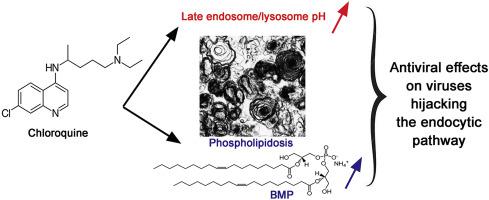Biochimie ( IF 3.3 ) Pub Date : 2020-05-30 , DOI: 10.1016/j.biochi.2020.05.013 Frédéric Carrière 1 , Sonia Longhi 2 , Michel Record 3

|
The anti-malarial drug Chloroquine (CQ) and its derivative hydroxychloroquine have shown antiviral activities in vitro against many viruses, including coronaviruses, dengue virus and the biosafety level 4 Nipah and Hendra paramyxoviruses. The in vivo efficacy of CQ in the treatment of COVID-19 is currently a matter of debate. CQ is a lysosomotrophic compound that accumulates in lysosomes, as well as in food vacuoles of Plasmodium falciparum. In the treatment of malaria, CQ impairs the digestion and growth of the parasite by increasing the pH of the food vacuole. Similarly, it is assumed that the antiviral effects of CQ results from the increase of lysosome pH and the inhibition of acidic proteases involved in the maturation of virus fusion protein. CQ has however other effects, among which phospholipidosis, characterized by the accumulation of multivesicular bodies within the cell. The increase in phospholipid species particularly concerns bis(monoacylglycero)phosphate (BMP), a specific lipid of late endosomes involved in vesicular trafficking and pH-dependent vesicle budding. It was shown previously that drugs like progesterone, the cationic amphiphile U18666A and the phospholipase inhibitor methyl arachidonyl fluoro phosphonate (MAFP) induce the accumulation of BMP in THP-1 cells and decrease cell infection by human immunodeficiency virus. HIV viral particles were found to be retained into large endosomal-type vesicles, preventing virus spreading. Since BMP was also reported to favour virus entry through hijacking of the endocytic pathway, we propose here that BMP could play a dual role in viral infection, with its antiviral effects triggered by lysosomotropic drugs like CQ.
中文翻译:

内体脂质双(单酰基甘油)磷酸盐作为氯喹对抗 SARS-COV-2 和劫持内吞途径的其他包膜病毒的作用机制中的潜在关键角色。
抗疟疾药物氯喹(CQ)及其衍生物羟氯喹在体外对多种病毒表现出抗病毒活性,包括冠状病毒、登革热病毒以及生物安全4级尼帕病毒和亨德拉副粘病毒。CQ 治疗 COVID-19 的体内疗效目前存在争议。CQ 是一种溶酶营养化合物,积聚在溶酶体以及恶性疟原虫的食物泡中。在疟疾治疗中,CQ 通过提高食物液泡的 pH 值来损害寄生虫的消化和生长。类似地,推测CQ的抗病毒作用是由于溶酶体pH值的增加和对病毒融合蛋白成熟过程中涉及的酸性蛋白酶的抑制所致。然而,CQ 还具有其他作用,其中包括磷脂沉积,其特征是细胞内多泡体的积累。磷脂种类的增加特别涉及双(单酰基甘油)磷酸酯(BMP),它是参与囊泡运输和 pH 依赖性囊泡出芽的晚期内体的特定脂质。先前的研究表明,黄体酮、阳离子两亲物 U18666A 和磷脂酶抑制剂花生四烯基氟膦酸甲酯 (MAFP) 等药物可诱导 THP-1 细胞中 BMP 的积累,并减少人类免疫缺陷病毒对细胞的感染。研究发现,HIV 病毒颗粒被保留在大的内体型囊泡中,从而防止病毒传播。由于据报道 BMP 还可以通过劫持内吞途径促进病毒进入,因此我们在此提出 BMP 可以在病毒感染中发挥双重作用,其抗病毒作用由 CQ 等溶酶体药物触发。









































 京公网安备 11010802027423号
京公网安备 11010802027423号